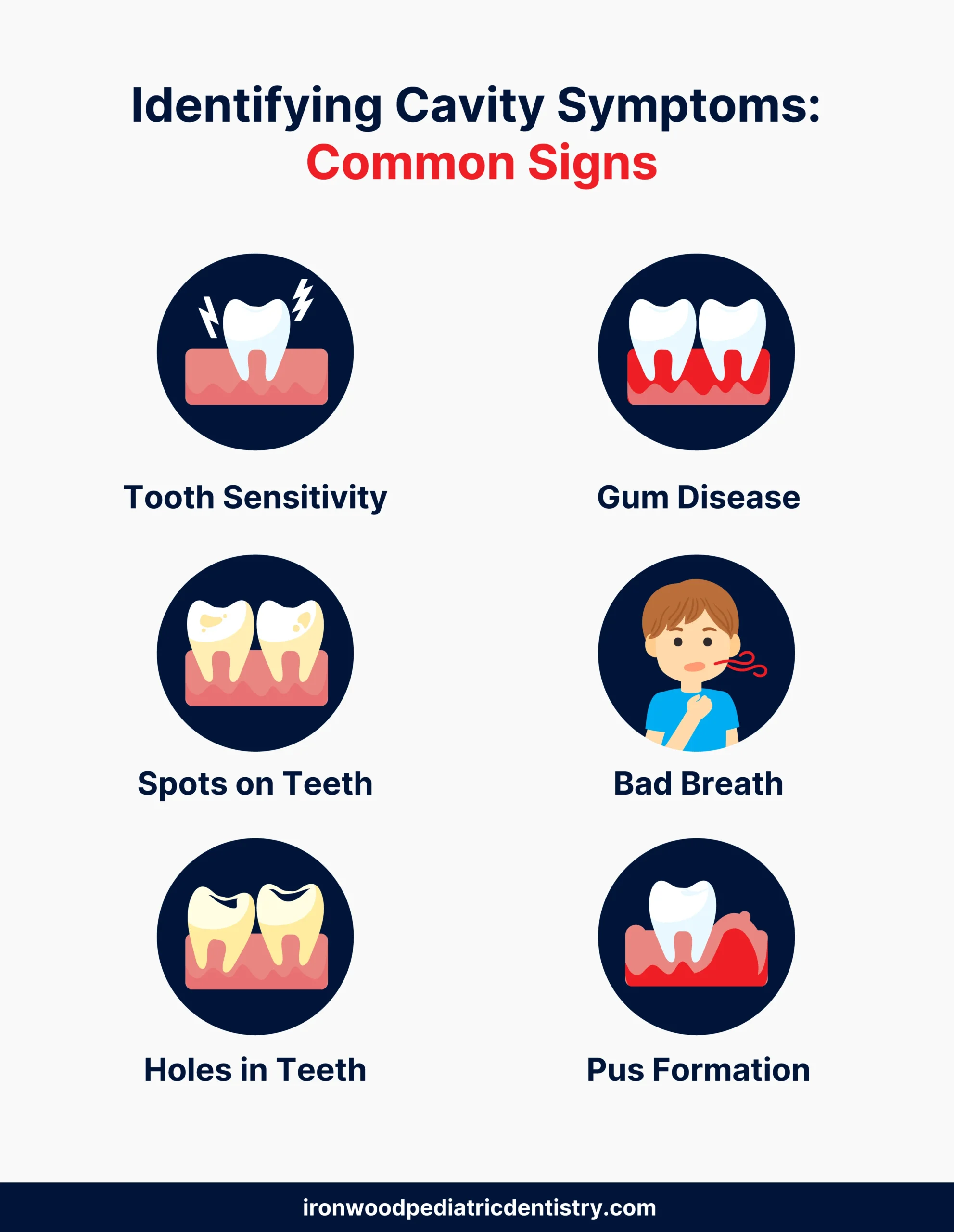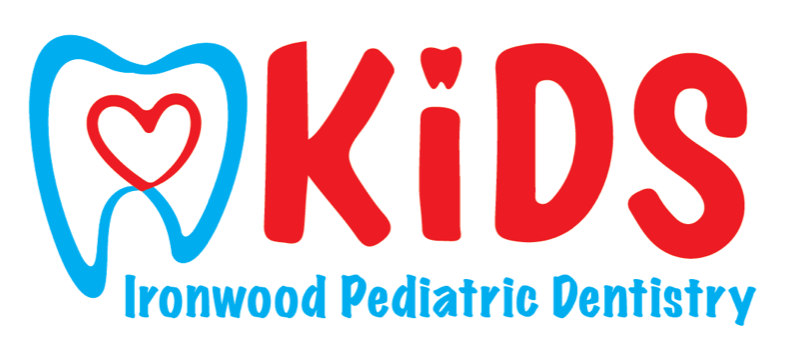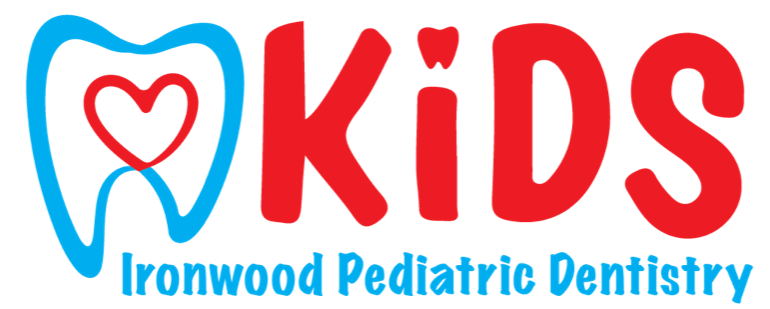Of all the reasons for child dental visits outside of a regular checkup, dental cavities are among the most common. But how can you tell if you have a cavity?
Also, what many parents want to know before they have to call the dentist to schedule a cavity filling is, “How could this have been prevented? What could my child and I have done differently? Is there anything we can do at home to treat a cavity?”
At Ironwood Dental, treating cavities is one of the pediatric dental services we provide to our clients at our office in Scottsdale, Arizona. If you believe your child has a cavity, call us at (480) 422-4544 to schedule an appointment for a dental filling.
If you want to learn ways to spot cavities in your children before they become serious, or better yet, to help them avoid getting cavities in the first place, then consider this your comprehensive cavity treatment and prevention guide.
What Is a Cavity?
Your child’s mouth is home to many kinds of bacteria, some of them harmful. These bacteria feed on food debris and sugar residue left behind after eating or drinking, and create acidic waste products that form plaque on tooth surfaces.
A cavity is a spot on the surface of a tooth that is compromised by plaque acids that eat away at the tooth enamel until a pit develops in the enamel. Unless it is treated by a dentist, a cavity will gradually get worse as the cavity grows and deepens until the more sensitive part of the tooth below the enamel becomes exposed. As this happens, your child will begin to experience the symptoms of tooth decay.
What are Risk Factors for Cavities?
Although bacterial plaque and acids are the direct causes of tooth decay and gum disease, these causes do not happen overnight. In our experience treating child dental patients in Scottsdale, here are some behaviors and conditions that contribute to the development of tooth decay:
- Poor tooth brushing and flossing habits. These can be either not brushing and flossing regularly or not doing so properly. This allows the teeth to collect food particles and for sugary foods and drinks to encourage the formation of dental plaque.
- Poor diet choices. Consuming foods and beverages high in sugar, like snack foods, can give mouth bacteria the fuel they crave to create the acid that leads to plaque and cavities.
- Heartburn and eating disorders. Stomach acid can be as destructive to tooth enamel as bacterial plaque acid. Medical conditions that lead to regurgitation of stomach acid into the mouth can contribute to the beginning of tooth decay.
- Lack of fluoride. Most local drinking water supplies are fluoridated, and most child toothpastes include fluoride in their formulas. But if your water supply is not fluoridated (for example, if your children mainly drink bottled water, which is not fluoridated) or you are using a non-fluoride toothpaste, a lack of fluoride can make tooth enamel more susceptible to tooth decay.
- Not visiting your child dentist regularly for dental checkups. If you visit our offices twice yearly for regular check-ups, often we can catch cavities early enough in their development to make simple treatments like cavity fillings. If you wait until your child complains to you about symptoms of tooth decay or gum disease, it might be too late for fillings.
- Certain medications. Some medications can have dry mouth side effects. Dry mouth conditions reduce the ability of saliva in your child’s mouth to at least partially neutralize the bacterial acids that form on teeth.
How to Tell if You Have a Cavity: Common Symptoms
There are several ways that cavities begin to make their presence apparent. Some symptoms of a cavity are physical (like pain). Others are visual, and sometimes you can tell by the smell. Here are the most common indicators that you have a cavity developing in one or more of your teeth, beginning with the early signs of dental caries and progressing through the growth of the cavity.
Tooth Sensitivity
Tooth enamel damage from a cavity can lead to your tooth becoming more susceptible to changes in temperature as the enamel becomes thinner. Your child may notice discomfort or pain when eating or drinking hot or cold foods and beverages, like ice cream, coffee or tea, or iced drinks. If your child is engaged in strenuous activity like running that leads to breathing through the mouth, the passage of air across the cavity surface can cause a tooth sensitivity reaction.
In some cases, tooth sensitivity can also be a reaction to the presence of sugars in the area of tooth decay.
Sometimes using a toothpaste for sensitive teeth can help with early tooth sensitivity. But as the cavity worsens, this will provide less and less relief as tooth sensitivity turns into a toothache.
Toothache
A toothache is one of the most common indicators that a cavity is present in its very early stages. The pain may start intermittently, like when putting pressure on the teeth by chewing. As the cavity grows and deepens, this pain will gradually become more frequent and sharper, until it will eventually become steady and throbbing even when your child is not eating or drinking.
Spots on Teeth
As tooth enamel corrodes, it can leave a visible spot on the tooth surface. This tooth discoloration can be light colored (“chalky teeth”) or brown or black in color.
Holes in Teeth
The eating away of tooth enamel, and then the layer underneath the tooth enamel surface called dentin, will create a physical hole in your tooth. In more significant cases of tooth decay, a tiny hole might become a crack in the enamel.
Sometimes you or your child will be able to see a hole in a tooth as a light- or dark-colored spot. Or, its presence can be felt with the tip of the tongue.
When tooth decay progresses to this point, treatment is advisable because untreated cavities can penetrate not only the enamel but also the dentin layer beneath the enamel. At this stage, the tooth root is now exposed, and it may take more advanced treatment, like root canal surgery or a crown, to fix.
By the time there are holes in the teeth, the pain and discomfort of a cavity have often reached the point where your child will want to see us.
Gum Disease
The same bacterial plaque that contributes to cavity formation also attacks your child’s gums. Gingivitis is the first stage of gum disease. You can detect it by the sight of gums that are red or swollen. As plaque hardens into tartar, it will begin to affect your child’s teeth and gums below the gumline. This stage of gum disease is periodontal disease. Its symptoms can include bleeding gums, sore gums, and loosening teeth.
Bad Breath
Persistent bad breath (halitosis) is a byproduct of tooth decay and gum disease. If your child notices a bad taste in his or her mouth when brushing, for example, this could be a sign of tooth decay-related halitosis.
Pus Formation
Pus in your child’s mouth is the body’s immune system attempting to fight off an infection that has worsened into an abscess. At this stage of tooth decay and gum disease, the underlying problem may be more than a cavity filling can fix. When pus is present, before any cavity fillings a deep cleaning will often be needed in combination with antibiotics to reduce the infection.

What is the Worst That Can Happen with a Cavity?
If we can find and treat a cavity in your child’s mouth early enough, then treatment can be relatively simple—sometimes a simple fluoride treatment to tooth chewing surfaces. But developing cavities left untreated for long periods can not only require more intensive remedies than dental sealants and fluoride treatments, they can lead to other medical problems that can affect aspects of your child’s life beyond eating, drinking, and smiling. In worst-case situations, these problems can lead to potentially life-threatening consequences:
- Bacterial infection, root decay, and Tooth loss.
- Tooth alignment problems that can come after tooth loss.
- Problems with chewing.
- Poor nutrition.
- Loss of appetite and weight loss.
- Tooth abscess infections that can spread to the bloodstream (septicemia).
Can You Treat a Cavity at Home?
Cavity prevention before cavities form is your best strategy to use at home. The best at-home remedies for cavities are things you can do to prevent cavities, like regular dental checkups, brushing your teeth and flossing twice daily and after meals, using a fluoride toothpaste, and rinsing with an antibacterial mouthwash to reduce bacteria in your mouth.
Tooth decay, once the signs of a cavity start, is not something you can fix at home. There is no over-the-counter product that can reverse enamel loss; dental fillings will usually be needed once this happens.
If you believe your child is showing signs and symptoms of early cavities, schedule an examination appointment with us so we can find and treat the problem as soon as possible.
Between the time you call us or contact us online to set up an appointment, here are five things you and your child can do to help alleviate early cavity symptoms:
- Use a fluoride toothpaste for sensitive teeth to reduce tooth and gum pain and discomfort.
- Use a warm salt-water rinse of 1 tablespoon of salt dissolved into ½ cup of warm (not cold) water. Salt water reduces oral inflammation and discomfort, discourages mouth bacterial growth, and can encourage gum tissue regeneration.
- A hydrogen peroxide rinse of 50 percent hydrogen peroxide and 50 percent water can have the same pain relieving effects as salt water rinse.
- A cold compress applied at 20-minute intervals to the outside of the cheek next to the cavity helps to reduce swelling and pain.
- Over-the-counter pain medications, like aspirin, acetaminophen, and ibuprofen, can help to relieve toothache pain.
Cavity Treatment for Children in Scottsdale, Arizona
Is your child currently experiencing tooth pain? Then call us now at (480) 422-4544 to schedule an appointment so we can fix it or treat any other oral health issues.
Are you wondering, “Where can I find child tooth decay treatment near me? Is there even a tooth decay dentist near me?” Then call Ironwood Pediatric Dentistry at the number above, or if you prefer, you can ask us online and we will get back to you.
Childhood tooth decay and cavities will not correct themselves once they get started. If you think your child might be suffering from a cavity, putting off treatment will not help. Call our dental team at Ironwood Dental now at (480) 422-4544 and let one of our children’s tooth decay treatment Scottsdale experts help take the pain away and keep it away.


